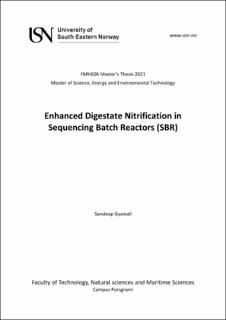| dc.description.abstract | The liquid fraction of digestates from anaerobic digestion contains a high concentration of Ammonium, which can be transformed into liquid “organic fertilizer”. Direct application of these digestates as fertilizer would lead to a significant nitrogen loss as ammonia. Therefore, it is necessary to convert it to a stable form of nitrogen for nitrate capture and slow release in biochar (i.e., nitrate impregnated biochar) that could be accepted commercially. Hence, nitrification of reject water was proposed for making the product stable. Two lab-scale parallel nitrification reactors were set up as sequential batch reactors (SBR). The main aim of this thesis is to achieve complete nitrification by tuning the operating parameters of SBR and finding optimum conditions. The study was performed using reject water (having 500 mg/L NH4-N) as feed obtained after dewatering of digested sludge from the Knarrdalstrand Wastewater Treatment Plant in Norway. Along with the reject water, synthetic feed was also used.
A series of laboratory analyses were performed for determining the concentration of Ammonium, Nitrite, Nitrate, organic matter (as TCOD, SCOD), and alkalinity. Moreover, analysis for measuring solids as TS, VS, TSS, VSS was carried out. In addition, the measurement of pH and dissolved oxygen were also carried out daily during the study period. Different operating conditions were tested by tuning one parameter at a time for achieving stable nitrification. The study is complemented with a continuous study of literature review.
During the early stage of the project, 47% of Ammonium was converted into Nitrite and only 11% of Ammonium was converted to Nitrate. However, after the addition of sufficient alkalinity, 98% of Ammonium was removed of which 80% was converted to Nitrite and only 18% was converted to Nitrate. Hence, alkalinity was one of the limiting factors for nitrification in this study. After alkalinity change, increasing the HRT from 1.67 days to 3.34 days by lowering the nitrogen loading rate from 0.3 kg/m3day to 0.14 kg/m3day helped to achieve complete nitrification. Moreover, changing the feeding sequence from two to one time a day helped to give enough contact time for bacterial biofilms and wastewater. Hence, HRT, nitrogen loading rate, and feeding sequence played a significant role and can be considered as important operating parameters for nitrification.
It is concluded that stable nitrification can be achieved using sequential batch reactors. Moreover, through nitrification, the liquid part of effluents from anaerobic digestors that treat municipal organic wet wastes can be successfully transformed into a high-quality liquid organic fertilizer that can be impregnated in biochar – as slow releasing and commercially acceptable fertilizer. | |
